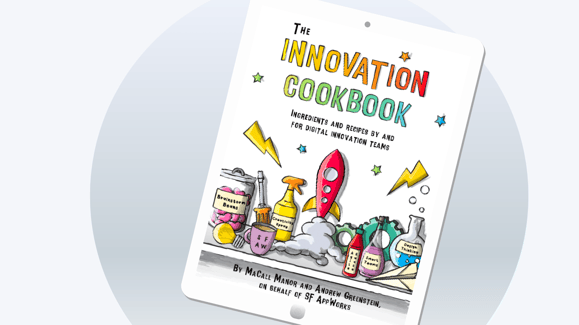We’re experiencing a pivotal moment in technology. A changing of the guard. One of those tectonic shifts that we’ll look back upon and say, “Nothing was the same after that.”
ChatGPT has captured our imagination in ways that blockchain was promised to, but never quite could. In ways that the metaverse promised, but never delivered. Your colleagues and friends and maybe even your parents are already using it in their day-to-day lives. And it’s helpful. If you couldn’t write well, now you can. If you could write well, now you can do it faster, maybe even better. (Did I use it to help write this? You’ll never know…) Its usefulness is why ChatGPT is the fastest-growing app of all time, reaching 100 million users just two months after its debut. It’s why it’s both awe-inspiring and terrifying.

This is a unique moment for makers everywhere. New technologies lead to new opportunities; new ways to disrupt existing business models (even ones that were just disrupted a few years back). ChatGPT can power a new wave of technological advancement that will change the way we work, create, and learn. And it’s coming at an opportune time – a time when the economy is barely keeping it together. Technology has been dragging the economy upwards for the past 15 years and just when it started to feel like we had reached the plateau, the clouds parted and generative AI appeared.
It can be hard to keep up. It feels like obvious ideas won’t stay un-created for long (even though you actually have more time than you think). While we can readily imagine how generative AI can and will change how we translate, write, create, email, cook, converse, and, of course, SEARCH, it’s hard to know where to plant your flag. We’re all trying to figure out how to get up to speed and where we can be 3 to 6 months from now, or however long it will take to create version one of your idea. And all the while, we have to weigh the facts that 1) we might only have one chance at this incredible opportunity (quit our jobs, go all in – you only do that once), and 2) whatever we pick, we have to balance the opportune-ness of it with our actual real interest (dare I say, passion?) in doing it for five or more years. Sure, maybe ChatGPT will revolutionize the way we think about auto-repair or vacation planning, but do we actually want to spend the next five years working on that?
It’s a lot to think about. A lot to weigh and consider. To make your decision easier, here are three ways to think about how to build on ChatGPT (or generative AI) to your competitive advantage.

Layer 1 - The UX Engine
We can’t pop open the hood and truly understand how ChatGPT works, but we can improve the shell around it. The first level of building on ChatGPT is to improve the interface. At its basic core, this could be experimenting with more visual ways of interacting, or plugging in more voice. It’s somewhat surprising that all the digital assistant companies (Amazon, Apple, Google) haven’t made it their number one priority to turn the engine of their voice into a ChatGPT-like experience. Or, maybe they’re working on it right now. Either way, form factor is worth considering and experimenting with.
But we can also play with the user experience to help people prompt better. Already the notion of a prompt engineer as a musical conductor of AI search is emerging, and because the new field has only existed for months, it’s anyone’s opportunity to become a leading expert. If you look closely at the amazing work that people are doing with ChatGPT, you’ll see much of the creativity and process comes from painstakingly working through the prompting process. From phrasing questions as hypotheticals to asking ChatGPT to role play, there are innumerable ways to seek an answer, and each way can present a different result. It may only take a few hours or days to learn how to manipulate ChatGPT for a narrow use case.
Can you save potential users that time by helping them create interesting, fruitful prompts? Take the example of a movie recommendation engine. You can start by asking it to recommend a few great movies. Here’s the list:


You can go deeper by saying, “Imagine you’re my buddy who comes over on Friday nights to watch movies with me. We watch movies like John Wick, Fast and Furious, and Ip Man. I’m not sure why we like these movies, but we don’t like other action movies. Can you describe what these movies have in common, and recommend a few more like them?”
Here’s the new list:



If you do the experimentation up front, find your target audience, then make it easy for them to stumble upon movies they’ll actually like, you’ll have created an experience that feels like magic, or mind reading. It’s not easy to do, of course, but the concept isn’t hard, and the engine powering it is now available, meaning you can create value for others with very limited technical skills and budget.
Layer 2 - Structured Data
ChatGPT was trained on a large body of information that includes Wikipedia, books, articles, scientific journals, and…the rest of the internet. It doesn’t access a single database of facts to answer your questions. That means it isn’t always accurate or correct. This presents an opportunity for entrepreneurs who want to use the engine of ChatGPT and apply it to a use case where accuracy or correctness is necessary – use cases in health care, finance, or law, for example. A medical startup might develop a database of symptoms and treatments for various conditions that ChatGPT could reference when providing health advice to patients. Or a financial services company could build a database of stock prices and company financials that ChatGPT could use to provide investment recommendations. The value add, in these cases, is the relevance and accuracy of the data, curated through expertise and experience and presented contextually and naturally.
Thinking about structured data can help entrepreneurs discover new opportunities that align with their own knowledge and interests, but it’s also a great way to explore integrating ChatGPT into existing digital products. If you have users, you have data. And if you have data, you have a proprietary ingredient that you can combine with ChatGPT to create a competitive edge.
Layer 3 - Personalization

We’ve explored how to use the engine of ChatGPT to supercharge your user experience, and how adding structured data can improve data accuracy, but perhaps the most powerful layer to add to a ChatGPT-powered product is user personalization. To some extent, this is already built in – if you start a session, you can ask follow-up questions and ChatGPT will remember past context. For example, I can ask ChatGPT for a 5-day itinerary to visit New York City, and it will provide one. I can then tell it that I’m a foodie and I love to walk. It will adjust the itinerary to incorporate my preferences. But all is forgotten once the session is closed.
Get a Free Copy Of The Innovation Cookbook

By adding a database and storing user preferences, you can essentially extend the session so that ChatGPT builds upon its learned knowledge of each user. Now, every time a user interacts with your digital product, ChatGPT enriches that user's profile. Suddenly, your fitness app can understand your goals, even as they change, and adjust the information and direction it provides.
The more a digital product ‘knows’ its users, the more defensible that product becomes. Years of data can lead to a level of familiarization that an alternative product would struggle to compete with.
These three layers of ChatGPT can correlate to whatever stage a product is in. If you have limited resources and data, your best bet is to play with the UX engine or form factor. If you have access to data but limited usage, you can explore structured data to create a competitive advantage. And if you have a long history of usage, you can supercharge personalization to create a defensibility moat. In any case, the technology is still new enough (for now!) to practically level the playing field. It’s anyone’s game. And it’s a fascinating and exciting time to watch, or build, the next great thing.

.jpg?width=300&name=working%20at%20laptop%20(2).jpg)
COMMENTS